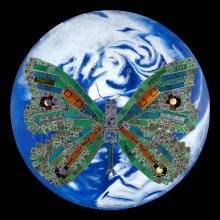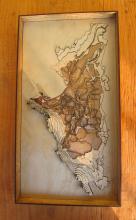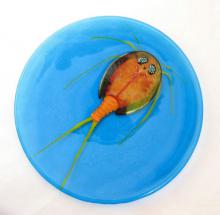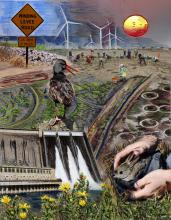About the Art Component
The Bay-Delta Science Conference has long been one of the foremost avenues for scientists in the Estuary to communicate their work. However, there are more ways to communicate than through power point presentations and posters. Using art and artistic principles to help communicate scientific concepts can enhance both scientific communication and artistic messages. At this year’s conference, we have solicited art that blends the line between art and science, and we have organized a panel discussion to explore how art and science can work together to increase awareness of estuarine ecology. Many of the exhibits are collaborative projects between members of the science community and local artists.
The Art of Data Visualization
Lunchtime Panel Discussion, Rooms 308-310
Nov. 17th, 12:15-1:00
Increasingly, new methods of data visualization are being leveraged to communicate science among scientists, between scientists and policy makers, and to the general public. In parallel, there is an increasing interest in using art for communicating scientific and environmental concepts with the public. This raises interesting questions about how to use art to inform better ways of displaying data. In this panel, we will hear from several experts in data visualization, communication, and technology, as well as several artists who have experience in scientifically-minded art. Each panel member will be asked to show at least one image/video and describe why they think it is compelling (2-3 minutes). Then the group will engage in a discussion on how art and science can be leveraged together to improve communication.
The panel will include data scientists, scientists who are also artists, and members of the art community who have worked with scientists for this year’s art exhibition on display in the poster hall.
- Jane Hartman - Art science specialist
- Amber Manfree (UC Davis) - GIS specialist and shadow puppet performer
- David Osti (34 North) - Data visualization scientist
- Gemma Shusterman (SFEI) - Data visualization scientist
- Christina Sloop (CDFW) - Aerial videographer and environmental scientist
- Bonnie Veblen - Artist and environmentalist
- Ariel Rubissow Okamoto (Estuary News) - Science writer and editor
Art and Science Exhibitors
On display in the poster hall.
Join the artists and scientists at the poster reception, 5:15-7:15 p.m. on Nov 15th and 16th.
Fish Kites - Alison Wells, Richard Perrin (local artists), and Meiling Roddam (State Water Board)
Richard, Alison, and Meiling have teamed up to present kites painted with fish of the Delta. Kites historically have been used as an S.O.S. communicator, but are also art that flies. Richard Perrin, a Jamaican Kite Master, constructed a Barbados kite, a Bermuda kite, and a Surinam fighter kite, that Alison Wells, acrylic artist, painted with a series of fish that are impacted by human use and abuse throughout the Delta waterways. Meiling Roddam, a scientist working with the State Water Board, provided the facts and knowledge of the Delta ecosystem.
Salt-Marsh Harvest Mouse sculptures - Jerry Morinaka, Laureen Thompson, and Sarah Estrella (CDFW)
The endangered Salt Marsh Harvest Mouse inhabits the northern and southern edges of San Francisco Bay and Suisun Marsh. This species thrives when there is a sufficient food source and cover; however, the loss of habitat (e.g. extensive development, sea-level rise, etc.) can be detrimental to the existence of this species. Jerry Morinaka is an Environmental Scientist working in the California Department of Fish and Wildlife’s Bay Delta Region office in Stockton, CA, and also as a part time artist who specializes in clay sculpture. He collaborated with Laureen Thompson and Sarah Estrella who are experts on the Salt-Marsh Harvest Mouse. Jerry is presenting two clay sculptures depicting Salt Marsh Harvest mice when conditions are good and when conditions are not so good.
Mixed Media Fish Sculpture - Angela Gonzalez (local artist) and Stacy Sherman (CDFW)
 Angela Gonzalez, in collaboration with CDFW employee Stacy Sherman, created a new piece to draw attention using recycled computer components and other objects to connect art, technology, and sustainability. Given the conference’s focus on the use of data to inform environmental decision-making in the Bay-Delta system, the use of objects and visual elements that reference technology can be a compelling tool to reinforce the key messages of the conference. Tactically, the art work could incorporate materials such as used fish sampling gear, objects found in the Delta and, naturally, recycled computer components, which are the common elements in all of Angela’s work. Fish will be the focal point and main visual element of the art piece.
Angela Gonzalez, in collaboration with CDFW employee Stacy Sherman, created a new piece to draw attention using recycled computer components and other objects to connect art, technology, and sustainability. Given the conference’s focus on the use of data to inform environmental decision-making in the Bay-Delta system, the use of objects and visual elements that reference technology can be a compelling tool to reinforce the key messages of the conference. Tactically, the art work could incorporate materials such as used fish sampling gear, objects found in the Delta and, naturally, recycled computer components, which are the common elements in all of Angela’s work. Fish will be the focal point and main visual element of the art piece.
Artist website: http://artbygonzalez.com
Image credit: Angela Gonzalez “Butterfly Effect”
Water Hyacinth Control - Bonnie Veblen (Local artist) and Erin Marineau (UC Davis and USDA)
In this piece, Bonnie and Erin collaborated to create a three-panel watercolor painting series based on Erin’s research on the impacts of water hyacinth (Eichhornia crassipes) management using herbicides on aquatic invertebrate communities in the Sacramento-San Joaquin River Delta. The first small panel depicts the historical Delta ecosystem. The large middle panel depicts the Delta in the present along with the findings from Erin’s research showing invertebrate communities before and after herbicide treatment. The type and number of zooplankton on either side will come directly from the data Erin collected. The final panel will depict a potential future delta ecosystem, based on scientist’s proposals for habitat restoration. This involves the removal of invasive vegetation, restoration of native aquatic vegetation, strategic removal of selected levees, increased channel complexity, and other water quality management activities.
3-D Delta Map - Marcia Ruth, (Kinesthetic Classics) and Miranda Fram (USGS)
 This project emerged from collaboration of a mother-daughter, artist-scientist team. Miranda Fram starts with the USGS Digital Elevation Model and National Hydrologic Dataset - using GIS software to transform the data into 12 layers - revealing topography and hydrology in three-dimensional sculpture. Then Marcia Ruth laser-cuts each layer in birch plywood, hand-assembles the pieces and builds frames for display. They will display an original sculpture of the Sacramento-San Joaquin Delta, calling attention to the subsided islands in the Delta. While words, numbers, and contour lines on flat paper may speak to scientists, a three-dimensional map communicates with the public. Moving their fingers across the landscape, people can actually feel their repeated descent into the “bowls.”
This project emerged from collaboration of a mother-daughter, artist-scientist team. Miranda Fram starts with the USGS Digital Elevation Model and National Hydrologic Dataset - using GIS software to transform the data into 12 layers - revealing topography and hydrology in three-dimensional sculpture. Then Marcia Ruth laser-cuts each layer in birch plywood, hand-assembles the pieces and builds frames for display. They will display an original sculpture of the Sacramento-San Joaquin Delta, calling attention to the subsided islands in the Delta. While words, numbers, and contour lines on flat paper may speak to scientists, a three-dimensional map communicates with the public. Moving their fingers across the landscape, people can actually feel their repeated descent into the “bowls.”
Artist website: http://KinestheticClassics.com
Image credit: Marcia Ruth
Delta Book Tryptic - Tamren Dong and Rachel Powell (local artists)
The story of the Delta takes place on multiple spatial and temporal scales,

which overlap and intertwine to form a multilayered landscape, from the geologic processes that formed the Delta to the daily tidal flux in a single slough. In order to recreate this complexity, Tamren Dong and Rachel Powell created three books laid out side-by-side, which combine into a continuous narrative of the Delta’s past, present, and future. The books contain eight art spreads, each illustrating a different aspect of the Delta’s ecology such as tidal influence, geologic history, wetland loss, fish passage, and hydrologic connectivity. The spreads will be cut into thirds and divided among the books so that when each book is turned to the same page, the complete spread is shown.
Artist website: http://tdoart.weebly.com
Image credit: Rachel Powell and Tamren Dong
Water Quality Paintings - Kimberly D’Adamo Green (local artist)
Kimberly worked with local scientists Bruce Herbold and Jim Hobbs to learn about the fish and ecology of the Estuary. She has produced six paintings exploring water pollution in the Bay-Delta, which will be on display at the conference.
Artist website: http://thatparticulargreen.com
“Connections” and “The Wish” - Harry Spanglet (CDWR) and Margaret Eldred (local artist)
Harry and Margaret will display two paintings exploring major issues in the ecology of the estuary. The first painting, “Connections”, portrays the watershed of the Sacramento-San Joaquin river systems from their headwaters in the Warner Mountains, Cascade and Sierra Nevada ranges to the San Francisco Bay Estuary. The painting uses a tree of life image to convey the interconnections between what happens in the headwaters and as the rivers flow through the Sacramento and San Joaquin valleys and the health of the Bay-Delta ecosystem. The second painting, “The Wish”, explores what would happen in these invaded wetlands if exotic species were successfully removed or controlled. It shows an idealized brackish marsh landscape, which is based on the tidal marshes of Rush Ranch. It focuses on native and endangered species flourishing in the absence of invasive plants, whose names appear on gravestones.
Artist website: http://eldredart.com
Delta Photography - Susan Conner
Susan will display three photographs, entitled: “Flight”, “Morning Peace” and “Delta Spring”. Curiosity brought Susan to the Delta, she had heard about the wildlife and wanted to photograph this special place. The first moments of being there were about flight and sound. It is an immense spectacle; to witness it means being still and taking in all that is around you. The close proximity to urban areas means there is a need to show people what exists within the Delta. Art allows a visual key and creates an understanding of what is there. Developing an appreciation for the Delta fosters a love and a passion for protecting this wonderful environment.
Artist website:http://susanseye.com
Don’t Forget the Little Guys - Jane Hartman (Special guest artist), Rosemary Hartman (CDFW), and Alison Furler (CDFW)
Alison, Rosemary, and Jane will be presenting a series of three tryptics. The first tryptic will be microphotography by Alison Furler of invertebrates that commonly appear in fish diets.  These invertebrates were collected from tidal wetlands in the Delta by the Fish Restoration Program Monitoring Team to assess the wetland’s fish food resources. The second tryptic, by Rosemary Hartman, will portray the same invertebrates as the first, using stained glass instead of photography. The final tryptic, by Jane Hartman, will portray the invertebrates using fused glass. Together, this work will help the audience gain an appreciation for the under-appreciated life of the Delta.
These invertebrates were collected from tidal wetlands in the Delta by the Fish Restoration Program Monitoring Team to assess the wetland’s fish food resources. The second tryptic, by Rosemary Hartman, will portray the same invertebrates as the first, using stained glass instead of photography. The final tryptic, by Jane Hartman, will portray the invertebrates using fused glass. Together, this work will help the audience gain an appreciation for the under-appreciated life of the Delta.
Artist website: http://trilobiteglassworks.weebly.com
Image credit: “Tadpole Shrimp” by Jane Hartman
Drone video - Christina Sloop (CDFW)
In a 3-5 minute video, Christina documents, via aerial imagery, some of the restoration sites/areas in the Delta and the science done/needed. This includes footage from the salinity barrier (last year), dry river channels, the confluence of the Sacramento and San Joaquin rivers, Liberty Island, and Yolo Bypass (in summer). The Delta is hard to see from the ground, but it is beautiful from above.
Enhanced Reality Virtual Sandbox - Jeanette Newmiller (UC Davis)
The Enhanced Reality Virtual Sandbox is a real sand box filled with white sand. Above it is an IR sensor from a X-Box 360 Kinect video game console and a projector. As sand is moved around in the sandbox the IR sensor reads the relative distance information to the computer which then projects topography with color gradient back onto the sand. You can also add virtual water to the image which appears to flow across the terrain and even splash when disturbed. The sandbox was developed a few years ago by Oliver Kreylos while he was a student at UC Davis. It has been installed at several science centers and museums since. Oliver made his design and software available through creative commons so now people all over are building them for educational uses but they are also mesmerizing to play with (Check it out)! This installation will accompany Jeanette’s scientific poster on a new computer model for environmental flows from the Sacramento River into the Yolo Bypass.
Collaging to Communicate Integration of Ecological Impacts, Human Actions, and Challenges for the Comprehensive Conservation and Management Plan 2016 - Afsoon Razavi (artist) and Ariel Rubissow Okamoto (Estuary News) (Science Writer and Editor)
 The San Francisco Estuary Partnership produced a Comprehensive Conservation and Management Plans representing regional agreement among multiple partners about priority actions to protect, restore or sustain the Estuary. The editor was challenged to provide visual relief in a plan with a rigid hierarchy of text blocks that had to be conveyed in the same order, format, and page length. The second challenge was to convey the strong theme of integration in the plan’s actions, and which also sought to connect the upper and lower Estuary (Delta and Bay). The Partnership wanted to do everything it could to convey the interrelationships among tasks and actions. The four collages are themed around CCMP’s broad goals: healthy habitats, resilience, water for all, and championing the Estuary. To create the collages, the editor assembled four folders of photos around the four goals. The artist then arranged the photos in a rough collage, and worked with the editor to balance the choice of species, landscapes, human activities, and other topics portrayed in each collage.
The San Francisco Estuary Partnership produced a Comprehensive Conservation and Management Plans representing regional agreement among multiple partners about priority actions to protect, restore or sustain the Estuary. The editor was challenged to provide visual relief in a plan with a rigid hierarchy of text blocks that had to be conveyed in the same order, format, and page length. The second challenge was to convey the strong theme of integration in the plan’s actions, and which also sought to connect the upper and lower Estuary (Delta and Bay). The Partnership wanted to do everything it could to convey the interrelationships among tasks and actions. The four collages are themed around CCMP’s broad goals: healthy habitats, resilience, water for all, and championing the Estuary. To create the collages, the editor assembled four folders of photos around the four goals. The artist then arranged the photos in a rough collage, and worked with the editor to balance the choice of species, landscapes, human activities, and other topics portrayed in each collage.
The artist had no background in the Bay-Delta science. The challenge for her was creating interesting and integrated compositions using a balance of images. In each of the posters, she used larger images of wildlife/species and human activities as visual anchors for the layout. She then added landscapes and other details to round out the topics portrayed. She also layered hand-drawn sketches on top of the collages photographs to create color and visual unity. Without the art added on top of the photography the sense of integration would not have been achieved.
This is just one of many reports where the editor has worked with other artists, mapmakers, and photographers on this panel to convey the key messages of science. All these experiences, suggest that those trying to convey science to policymakers and the public should include strong and imaginative graphics, and should not be afraid to break out of GIS or PowerPoint platforms.
